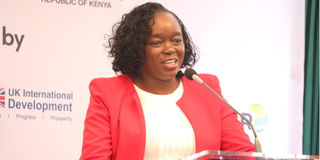Government launches early warning plan to combat disasters

Environment Cabinet Secretary Deborah Barasa, during the launch of the Early Warnings for All (EW4All) initiative in Kenya on May 21, 2025 ,at Radisson Blu, Upperhill in Nairobi.
What you need to know:
- Findings of a report released last year indicate that whilst climate change continues to impact the country significantly, there exist large gaps in observational data on the continent, making it difficult to determine how some aspects of climate will evolve in the future.
- The “Early Warnings for All” (EW4All) initiative in Kenya will ensure that everyone, everywhere, is protected by life-saving early warning systems by 2027.
- The foundational pillars of the Early Warnings For All initiative is based on four components, Know the risks, Watch and Predict, Get the message out, Be ready.
The government has launched an initiative aimed at protecting lives and livelihoods during disasters. The Early Warnings for All Initiative is built on four pillars designed to enhance the country’s response to calamities such as droughts, floods, and disease outbreaks.
The move comes in response to the growing challenges posed by climate change, which has exacerbated the frequency and intensity of such crises in Kenya. Findings of a report released last year indicate that whilst climate change continues to impact the country significantly, there exist large gaps in observational data on the continent, making it difficult to determine how some aspects of climate will evolve in the future.
The initiative is anchored on four pillars, including data collection and risk assessment, observation and forecasting and dissemination and communication. The Early warning for all also includes national and community response capabilities.
Speaking during the official launch of the initiative on Wednesday, Cabinet Secretary for Environment, Climate Change, and Forestry, Dr Deborah Mlongo Barasa, emphasised the importance of leveraging data modelling to provide timely, accurate, and actionable information to key stakeholders.
“Every Kenyan - regardless of where they live or what language they speak- deserves access to life-saving information before disaster strikes. This Initiative will do exactly that. Let us therefore unite, collaborate, engage, and build an Early Warning System in Kenya that will reduce loss of life and livelihoods, bolster food security, and build a more resilient Kenya for generations to come”. Five per cent of the national disaster risk management will go into the upgrading of early warning systems in various institutions, she added. She also called on county governments to include sub-county and ward-level early warning outreach activities in their budgets for the 2025/26 financial year.
In February, Kenya submitted its Nationally Determined Contributions (NDC) for 2031 and 2035 to the United Nations Framework Convention on Climate Change (UNFCCC), outlining their climate action plans and targets to reduce greenhouse gas emissions and adapt to the impacts of climate change.
“A key component of this NDC is strengthening early warning systems to enhance resilience and protect vulnerable communities from the impacts of climate change. This includes improved monitoring and forecasting capabilities, expanded data collection networks and better integration of climate risk information into decision-making processes, ” said Dr Festus K Ng’eno, Principal Secretary, State Department for Environment and Climate
Change in Kenya.
Key stakeholders such as the Kenya Red Cross, Kenya Meteorological Department, National Disaster Management Unit, and national and county governments will play an instrumental role in realising the program’s goals.
Dr David Gikungu, Director, Kenya Meteorological Department, said the various players will leverage on the initiative to seal the gaps in sparse infrastructure. “ By increasing the number of observation stations, particularly in underserved regions such as the expansive Arid and semi-arid counties and vulnerable coastal zones, we aim to meet global standards for early warning observational capabilities.”
The launch of Kenya’s initiative follows the United Nations’ unveiling of a similar global effort—Early Warnings for All (EW4All), which was introduced in December 2023 in Mauritius. The UN’s global drive aims to ensure that by 2027, everyone is covered by a multi-hazard early warning system. In March this year, Kenya launched the National Framework for Climate Services, which aims to assess current capacities and identify gaps in climate-related services.
Neil Wigan, the British High Commissioner to Kenya, praised the partnership between Kenya and the UK Met Office, highlighting its significant contribution to enhancing weather forecasting capabilities. This collaboration aims to improve the accuracy and reliability of weather predictions, strengthening Kenya's resilience to climate-related challenges.
“During my time in Kenya, I have seen firsthand the devastating effects of climate change, including in Mathare, where last May I saw how floods caused the displacement of families, wiping out livelihoods. Through our weather and climate information services programme, delivered in partnership with the Kenya Meteorological Department, authorities in Garissa and Tana River Counties use seasonal forecasts to develop action plans, helping to prevent disasters. Today’s launch means we’re going further, together.”
According to the 2024 Kenya Red Cross flood operations report, the March-to-May floods claimed over 294 lives, displaced about 55,000 households, killed 11,000 livestock, and damaged 65,000 acres of farmland. Zablon Shilenje, a representative from the World Meteorological Organisation, emphasised the need to strengthen institutions for improved generation of hazard information, strengthen existing technological innovations, fill the gaps in environmental monitoring, weather observation, improved infrastructure, and forecasting for early warning services.
The United Nations Resident Coordinator in Kenya, Dr Stephen Jackson, reaffirmed the commitment of the United Nations “to support a successful implementation of the initiative” and stressed the importance of the Early Warning Roadmap that will “serve as a strategic guide to drive initiatives at both national and local levels, channel investments towards enhancing Early Warning Systems for more effective Disaster Risk Reduction and facilitate the seamless integration of comprehensive early warning mechanisms.”
A three-day engagement workshop with key stakeholders will follow the launch.

